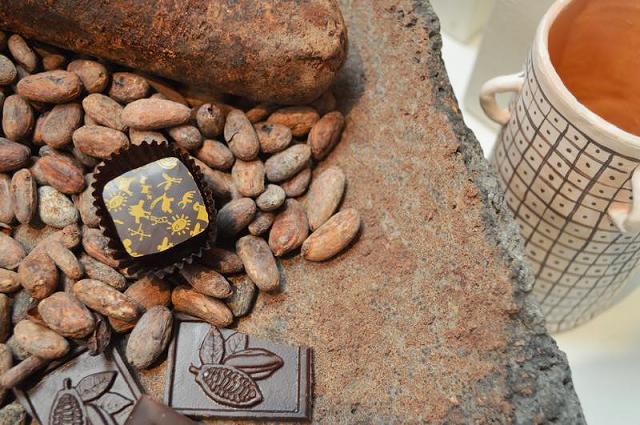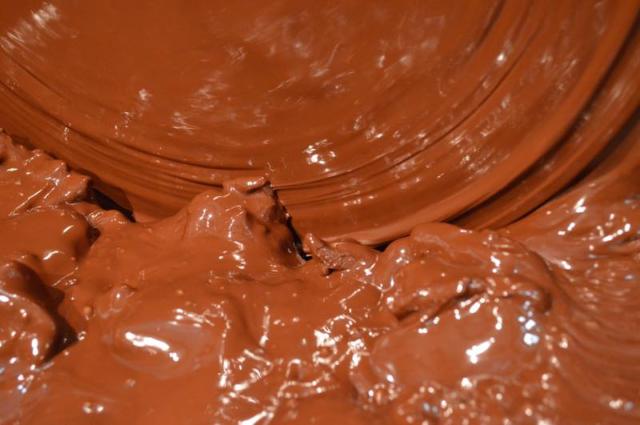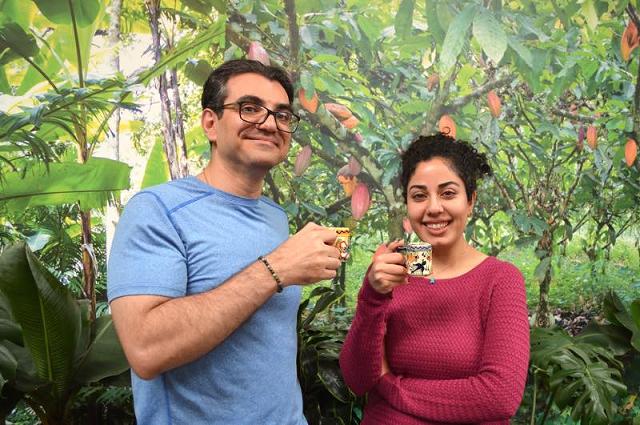 |
Canku Ota
|
 |
|
(Many Paths)
|
||
|
An Online Newsletter
Celebrating Native America
|
||
|
August 2017 - Volume
15 Number 8
|
||
|
|
||
|
Chocolate Time Travel
In A Cocoa Bean
|
||
|
by Frances Madeson -
Indian Country Today
|
||
|
How to characterize
the many flavors of chocolate? Sometimes, only a moan will do
Craft culture is alive and well in Santa Fe. Multiple micro-breweries, coffee roasters and a robust farm-to-table movement have all been fully integrated into the enthusiastic and ever-burgeoning local foodie scene. But with last autumn's arrival of Cacao Santa Fe, the "City Different" has its first bean-to-bar chocolatiers who think the experience of eating chocolate gets better the more you know about the art and culture of chocolate-making. Partners Melanie Boudar and Derek Lanter offer a fun, informative and unforgettably delicious two-hour, hands-on chocolatiering and tasting workshop called "Food of the Gods." Besides the fact that your taste buds will thank you, the session is named for Theobroma cacao, the scientific name for the tree that produces the pods in which the beans are found, translated from the Greek — theos meaning god, broma meaning food. These transplants from Hawaii have arrived in New Mexico with a mission — to share the history and how-tos of chocolate and move its partakers from the role of happy passive consumers to happy active appreciators. For them the yummy brown stuff isn't merely a mood-enhancing confection but is also a lens into historic indigenous cultures in Mesoamerica, where elixirs were used ritually, medicinally and spiritually, not to mention as an energy-boosting aphrodisiac. "Aztec ruler Montezuma reportedly drank a staggering fifty cups of chocolate a day while making the rounds of his four thousand concubines," Boudar explained.
While cracking and removing the shell from the already roasted beans (a process called winnowing) and grinding the fatty beans into a thick paste, workshop participants learn about the growing and harvesting processes. "Growers can't usually afford to have their farms certified organic," explained Boudar, who leads the workshops, "but they're organic by default. The trees are not sprayed, the outer husk of the pods and beans themselves are thick and dense, so bugs can't get at them. The process hasn't changed much for a thousand years."
Twice a year the trees are covered with flowers, and if the flowers are pollinated they turn into pods, which contain the beans. There's usually one big harvest and one smaller harvest. All told, a tree might produce 50 pods in a year, and each pod may produce a single bar of chocolate. We have the Mayans to thank for preparing complex chocolate beverages in their ceremonies, which often centered on drinking something from nature. Their chocolate was prepared without sugar, which did not arrive on the continent until the early 1600s. It was mixed instead with flowers, seeds and spices. "They sipped from the cacao bean pod itself, which served as a ceremonial vessel," Boudar said. The Aztecs lived farther north where it was high and dry, but they taxed the Mayan farmers, taking beans in payment. By 1500, beans were used as everyday currency. There's a conversion chart that shows the valuations — you might be surprised to see how many or few beans were traded for a chicken. "As people are people," Boudar said, "they counterfeited the beans, making fakes from clay and dough." For New Mexicans, history was brought even closer to home about ten years ago, when archeological researchers found chocolate residue coating pots found in the Anasazi ruins of Chaco Canyon. "They found Macaw feathers in the pots too, and turquoise in the Yucutan. This points to trading among the ancients," Boudar explained, "and the spread of chocolate making across thousands of miles."
Part of the fascination of the workshop is contrasting the modern-day equipment needed for contemporary chocolate making with the few simple tools and processes the ancients used. "Mayan ladies would take the cracked beans and shake them in a bowl, and wait for a breeze to take the shells or else pick them out by hand," she informed us. Like the Italians who prize crema on their espresso, the Mayans love foam on top of their hot chocolate, and use a special tool called a molanillo, which has a spinning action, and which is carved from one piece of wood. "It's essentially a Mexican whisk," Boudar explained, passing it around. The final segment is spent tasting a flight of seven bar chocolates, some made in-house, some from other craft makers, and learning how to talk about their distinct flavors. More learning by doing — or in this case, chewing. The chocolate students really did try to find the right adjectives for the seven bites that ended up on surprised tongues — flowery? leathery? smokey? ashy? earthy? but sometimes a moan just had to do. You can reserve a slot in an upcoming Food of the Gods Workshop at Cacao Santa Fe, 3201 Richards Lane Santa Fe, New Mexico, by visiting their website. |
||||||||
|
|
|
||
|
|
||
| Canku Ota is a free Newsletter celebrating Native America, its traditions and accomplishments . We do not provide subscriber or visitor names to anyone. Some articles presented in Canku Ota may contain copyright material. We have received appropriate permissions for republishing any articles. Material appearing here is distributed without profit or monetary gain to those who have expressed an interest. This is in accordance with Title 17 U.S.C. Section 107. | ||
|
Canku Ota is a copyright ©
2000 - 2017 of Vicki Williams Barry and Paul Barry.
|
||
 |
 |
|
|
The "Canku
Ota - A Newsletter Celebrating Native America" web site and
its design is the
|
||
|
Copyright ©
1999 - 2017 of Paul C. Barry.
|
||
|
All Rights Reserved.
|
||



